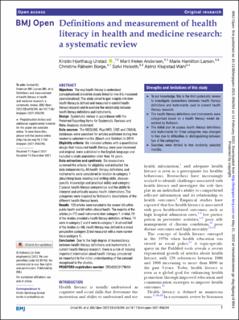| dc.contributor.author | Urstad, Kristin Hjorthaug | |
| dc.contributor.author | Andersen, Marit Helen | |
| dc.contributor.author | Larsen, Marie Hamilton | |
| dc.contributor.author | Borge, Christine Råheim | |
| dc.contributor.author | Helseth, Sølvi | |
| dc.contributor.author | Wahl, Astrid Klopstad | |
| dc.date.accessioned | 2022-06-17T08:28:15Z | |
| dc.date.available | 2022-06-17T08:28:15Z | |
| dc.date.created | 2022-04-22T13:02:31Z | |
| dc.date.issued | 2022 | |
| dc.identifier.citation | BMJ Open. 2022, 12 (2), . | en_US |
| dc.identifier.issn | 2044-6055 | |
| dc.identifier.uri | https://hdl.handle.net/11250/2999236 | |
| dc.description.abstract | Objectives The way health literacy is understood (conceptualised) should be closely linked to how it is measured (operationalised). This study aimed to gain insights into how health literacy is defined and measured in current health literacy research and to examine the relationship between health literacy definitions and instruments. Design Systematic review in accordance with the Preferred Reporting Items for Systematic Reviews and Meta-Analyses statement. Data sources The MEDLINE, PsycINFO, ERIC and CINAHL databases were searched for articles published during two randomly selected months (March and October) in 2019. Eligibility criteria We included articles with a quantitative design that measured health literacy, were peer-reviewed and original, were published in the English language and included a study population older than 16 years. Data extraction and synthesis Six researchers screened the articles for eligibility and extracted the data independently. All health literacy definitions and instruments were considered in relation to category 1 (describing basic reading and writing skills, disease-specific knowledge and practical skills) and category 2 (social health literacy competence and the ability to interpret and critically assess health information). The categories were inspired by Nutbeam’s descriptions of the different health literacy levels. Results 120 articles were included in the review: 60 within public health and 60 within clinical health. The majority of the articles (n=77) used instruments from category 1. In total, 79 of the studies provided a health literacy definition; of these, 71 were in category 2 and 8 were in category 1. In almost half of the studies (n=38), health literacy was defined in a broad perspective (category 2) but measured with a more narrow focus (category 1). Conclusion Due to the high degree of inconsistency between health literacy definitions and instruments in current health literacy research, there is a risk of missing important information about health literacy considered be important to the initial understanding of the concept recognised in the studies. | en_US |
| dc.language.iso | eng | en_US |
| dc.rights | Navngivelse-Ikkekommersiell 4.0 Internasjonal | * |
| dc.rights.uri | http://creativecommons.org/licenses/by-nc/4.0/deed.no | * |
| dc.subject | Helsekompetanse | en_US |
| dc.title | Definitions and measurement of health literacy in health and medicine research: A systematic review | en_US |
| dc.title.alternative | Definitions and measurement of health literacy in health and medicine research: A systematic review | en_US |
| dc.type | Peer reviewed | en_US |
| dc.type | Journal article | en_US |
| dc.description.version | publishedVersion | en_US |
| dc.source.pagenumber | 0 | en_US |
| dc.source.volume | 12 | en_US |
| dc.source.journal | BMJ Open | en_US |
| dc.source.issue | 2 | en_US |
| dc.identifier.doi | 10.1136/bmjopen-2021-056294 | |
| dc.identifier.cristin | 2018411 | |
| cristin.ispublished | true | |
| cristin.fulltext | original | |
| cristin.qualitycode | 1 | |

